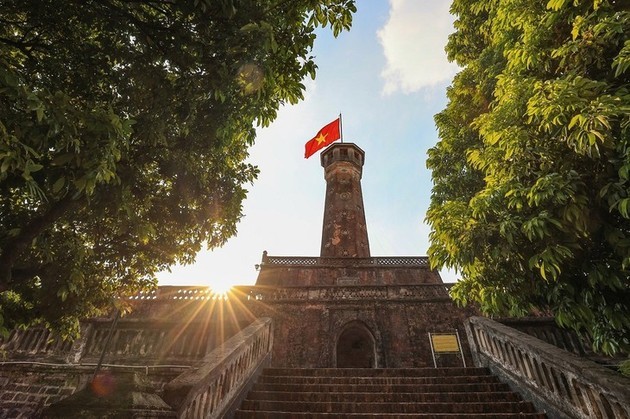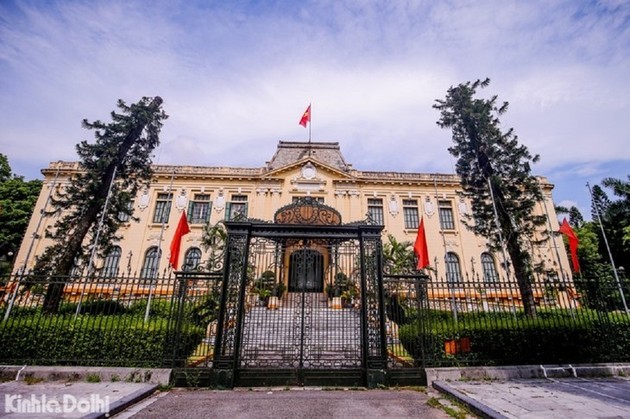 Long Bien Bridge is over 100 years old. It’s a “historical witness” of important milestones of the capital Hanoi. On October 9, 1954, the last French soldiers withdrew across Long Bien Bridge, and the Vietnamese liberation army and people completely took control of the capital. (photo: VOV Giao thong) Long Bien Bridge is over 100 years old. It’s a “historical witness” of important milestones of the capital Hanoi. On October 9, 1954, the last French soldiers withdrew across Long Bien Bridge, and the Vietnamese liberation army and people completely took control of the capital. (photo: VOV Giao thong) |
B: This week, many listeners including Xyanhaphet of Laos shared their interest in the celebration of the 70th anniversary of Hanoi’s Liberation Day (October 10).
A: On October 10, VOVWORLD will have a special program on this occasion.
B: Many celebratory activities are underway including photo exhibitions, book exhibitions, an art exhibition featuring seventy paintings, graphic works and sculptures highlighting Hanoi’s vitality in various eras of the history, the Hanoi Ao Dai campaign and the Hanoi Tourism Ao Dai festival encouraging the public to wear Ao dai or traditional long dress of Vietnam.
A: On Sunday, at the Hanoi Cultural Festival for Peace, more than 8,000 people, representing all districts, agencies, and forces in the capital, attended a parade and cultural and art performances, featuring the capital’s intangible cultural heritages and traditions.
 In 1945, the August Revolution succeeded and the red flag with a yellow star was hoisted for the first time on the Hanoi Flag Tower. On October 10, 1954, the flag-raising ceremony at the Hanoi Flag Tower marked a historic milestone of the Vietnamese nation: the capital Hanoi was liberated. (Photo: baogiaothong.vn) In 1945, the August Revolution succeeded and the red flag with a yellow star was hoisted for the first time on the Hanoi Flag Tower. On October 10, 1954, the flag-raising ceremony at the Hanoi Flag Tower marked a historic milestone of the Vietnamese nation: the capital Hanoi was liberated. (Photo: baogiaothong.vn) |
B: Traditional art forms such as ca trù (a form of chamber music), water puppetry, and xam singing, and re-enactments of folk belief rituals worshipping Saint Tan Vien, the Trung Sisters, and Saint Giong have honoured the eternal cultural values of Hanoi.
A: A grand ceremony to celebrate the 70th anniversary of Hanoi’s Liberation Day will be held at the National Convention Centre on October 10 with the participation of about 3,000 delegates.
B: These days, Hanoians are often recalling the historic day 70 years ago with excitement and pride.
"The night before, everything was eerily quiet because the French had left, but our troops hadn’t arrived yet. The next morning, when the soldiers entered the city, we all rushed out to see them. I was only 12 years old at the time, so I had to stand on a chair to get a better view. The boys even climbed lampposts to watch the liberation of the capital. These are priceless, unforgettable memories,' said a local of Hanoi.
"At the eve, the streets were quiet. Every house had its doors closed. But when people saw the red flag with the yellow star waving, all the doors opened at once. The atmosphere was electric. The peaceful takeover of the capital was the result of a long struggle on political, military, and other fronts. It was also the fulfillment of an oath to sacrifice everything for the Fatherland,' another resident of Hanoi said.
B: Moving on, we received a passionate comment from Mario Muñoz Mendoza of Bolivia. He wrote: “General Secretary and President of Vietnam To Lam’s visit to Cuba is very meaningful because it will contribute to strengthening bilateral cooperation, aiming at the development and happiness of the people of each country. We are confident that Vietnam is a major investor in Cuba and that during this visit, Vietnam's investment will increase exponentially.”
A: Mario, we truly appreciate your enthusiasm and solidarity! Vietnam’s relationship with Cuba is indeed a special one, based on mutual respect and support. General Secretary To Lam’s visit underlines the strong ties between our nations. Your confidence in Vietnam’s growing investment in Cuba echoes the sentiment of many, and we hope this partnership will continue to bring prosperity to both our peoples.
B: Juan Diez of Santander, Spain, shared his thoughts on Vietnam’s support for Cuba, saying, “10 thousand tons of rice, 500 computers donated to the Central Committee of the Communist Party of Cuba, gifts from the Vietnam General Confederation of Labor to the Cuban Workers' Center and gifts from Vietnamese localities to the Cuban people are all valuable, because they are gifts from Vietnamese workers to Cuban workers, contributing to the union of the two peoples.”
A: Juan, you’ve captured the essence of these meaningful gestures. The aid provided by Vietnam to Cuba represents the strong bond between the workers of both countries. It’s wonderful to see that this effort resonates with listeners like you, who understand how these gifts contribute to the unity of our nations.
 Tonkin Palace, which is now the Government Guest House, is one of the first places in Hanoi that the Vietnam People's Army took over on October 10, 1954. (Photo: kinhtedothi.vn) Tonkin Palace, which is now the Government Guest House, is one of the first places in Hanoi that the Vietnam People's Army took over on October 10, 1954. (Photo: kinhtedothi.vn) |
B: We also heard from our Indian listeners, who reached out to express their concern after Typhoon Yagi. They were closely following our coverage on the impact of the storm and recovery efforts.
A: To all our Indian listeners, thank you for your heartfelt support. The Vietnamese people appreciate the solidarity shown by our friends around the world. We’ll continue to keep you updated on the progress of recovery and the resilience of our communities.
B: Over on Weibo, our Chinese listeners have been engaging with our posts, especially those related to Vietnam-China relations. Fan Hong Jie from Zhejiang and Zhao Ya Dong from Shanghai praised the close coordination between the two countries’ peoples.
A: Thank you, Fan Hong Jie and Zhao Ya Dong for your kind words. We value the cultural exchange between Vietnam and China, and it’s always heartening to see the friendship between our two nations being celebrated by our listeners.
B: Muhammad Aqeel Bashir from Pakistan wrote: “Your program not only conveys news about the country and people of Vietnam but also international news. I appreciate your efforts. Thank you again for always connecting with the audience and sharing valuable content.”
A: Muhammad, thank you for your appreciation! We strive to bring our listeners a well-rounded view of Vietnam and the world. Your feedback encourages us to keep delivering valuable content that informs and connects us all.
B: Lianan Safitri of Indonesia shared her interest in our stories about Vietnam, its land and people. She wrote: “You can see the seriousness in preserving the culture of each ethnic group. I am curious about Vietnamese folk songs and lullabies. If possible, I would like to hear Vietnamese folk songs or lullabies.”
A: Lianan, thank you for your interest in Vietnamese culture! We’re proud of the diverse traditions preserved by our ethnic communities. Vietnamese folk songs and lullabies, are an integral part of our heritage.
B: The lullaby, a priceless cultural asset of the Vietnamese, has passed down to children the spiritual values of the community. The lullaby is also a precious life-affirming lesson that helps form personalities and ethics.
A: The lullaby is the oldest genre of folk song and has been passed down from one generation to another. From the day they are born, children absorb with the most loving, sweetest feelings from their mothers or grandmothers through lullabies.
B: A lullaby is soft, sweet and emotional, expressing the meaning of life. The images of a river, moonlight, a rice field, grass, bamboo groves and white storks flying over a vast green rice field have entered childhood dreams. The lyrics, which are taken from folk verses, children’s songs or chanting, are simple and rich in images and melody. Each region has its own lullaby, but all help lull the child to sleep.
A: Listening to lullabies, children feel the love, tenderness and comforting. “Baby, sleep well! Your mom is busy planting rice seedlings. Catching some fish, cat fish, she will bring them home for you, baby, to eat”.
"During war time, I stayed in the evacuation zone in Phu Tho province. Because of blackout during the summer, the children were lulled to sleep by their mothers or grandmothers with hand fans. Singing lullabies and rubbing the child’s head and back, the woman warmed up her child, who quickly fell into a deep sleep. Although they were not singers, their voices were expressive. Those were unforgettable memories”.
A: You’ve listened to Pham Hong Chuong, a lecturer of the Central Music and Painting Teacher Training College, sharing his impression with lullabies.
B: A lullaby which is passed down orally has many variants. Amidst urbanization and the modern lifestyle, mothers have little time for their child and there are fewer opportunities for songs. In a bid to preserve the lullaby, Vietnam’s Ministry of Culture, Sports and Tourism is working with localities to organize lullaby festivals. Artist Cao Thi Hien told us: “We have worked on programs to teach lullabies to young parents. It bears human characteristics, educates children and praises the home country. We are trying our best to restore and preserve this particular kind of national art”.
B: And with that, we wrap up this week’s listener feedback. Thank you to everyone who wrote or called in. Your thoughts and questions mean the world to us. Keep them coming, and we’ll continue to share your voice with the world!